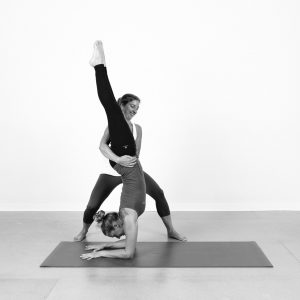This pose is a strong forearm balance and an invigorating inversion. It’s not a suitable pose for beginners but it is great for intermediate and advanced classes as there are stages of attainment. In the full expression of the pose you would float your legs up unassisted, free balance for 5-10 breaths and then exit gracefully – possibly into chaturanga!
Working towards that involves using props such as a block, the wall or having a partner / teacher to assist. Ideally you practice Pincha Mayurasana with an assist rather than a wall, as this will best facilitate your progression towards unassisted free balancing.
Using a wall can encourage the common misalignments of over-arching the lower back and a flaring of the ribs and also it will impede your ability to ‘feel’ the centre of balance. When you hop up to free balance you need the first leg to go past the centre line while you begin to raise the second leg, then you bring both legs together like scissors. A wall would prevent this movement.
Technique: If you choose to use a block place it on its side at the front of your mat, or against the wall if using a wall. Place the palms and forearms on the floor, the block between your thumbs and forefingers. Your forearms should be parallel to each other and shoulder-width apart with palms flat on the floor.
Tuck the toes and lift the hips to straighten the legs so you are in a Dolphin pose (like Downward Facing Dog but on forearms). Bend one knee bringing the foot closer to your hands keeping the other leg straight.
Ensure your shoulders are above your elbows, look down at the floor towards your thumbs, kick off with the bent leg and lift the back leg (the straight one) up so the spine is vertical. If you are being assisted they should help you find your centre of balance as you attempt to hold the pose. If you are using a wall, try and take you feet off the wall and free balance, even for a moment. Leaving your feet on the wall will just encourage you to be in a banana shape!
Ensure your elbows do not splay out, that your shoulder blades are engaged and keep them firm into your back. You need to keep a strong core so you don’t collapse through the lower back and maintain a steady gaze towards the floor.
To release, take one foot down at a time on the exhalation. Rest in Balasana, Child’s pose.




Contra Indications and Cautions: This pose should not be attempted if you have a back, shoulder or neck injury or high blood pressure. As with any inversion, it is not advised if you are menstruating or during pregnancy unless you are an experienced practitioner.
Benefits: Pincha Mayurasana is an excellent way to strengthen the shoulders, arms and back. It stretches the neck, chest, shoulders and abdomen while also improving your sense of balance. On a deeper level the pose calms the brain and can help relieve stress and mild depression. There is a wonderful sense of accomplishment in achieving this pose, in free balancing and in successfully mastering the entry unassisted.





